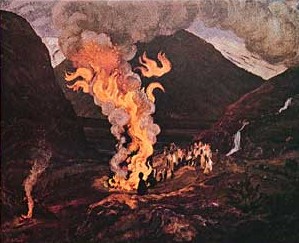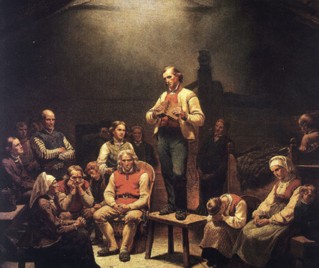|
Of Norwegian WaysOf Norwegian Ways The comments here are paraphrazed from a customer review at Amazon.com. You may read this review in the original by using the link above. Many people overlook the value of preserving their cultural heritage, including myself. I am of Norwegian ancestry, but have lost touch with my cultural heritage. Being of Norwegian ancestry, I read with interest Bent Vanberg's book Of Norwegian Ways, which described many aspects of Norway. Norway's religious history and traditions specifically interested me. Bent Vanberg's main views throughout the few chapters I selected is Norway is a place full of distinguished history and centuries old religious traditions, which are used by the Norwegians to pass on their cultural heritage. Of Norwegian Ways Norwegian's, like any other cultural group, used the functions of religion to provide social control, explain and understand the unknown, reduce their fears and anxieties, and reinforce their identity with each other. From the first time Norway was inhabited, the Norwegians believed in polytheism and created lively gods and goddesses with supernatural powers to explain the things they could not. They depended upon these gods for things such as healthy crops, fertility, and calm seas. A few of the major deities that controlled the Norwegian universe were: Odin, chief god; Tor, his strong aide with a magic hammer; Balder, who was kind and saintly; Njord, the wind and fire god; Aege, god of the seas; Freya, goddess of love; and Vaar, goddess of fidelity. Each god and goddess had mannerisms the Norwegians were familiar with. This made them easier to believe in. Norwegians had rituals or rites of intensification to signify events of crisis such as lack of rain or death of a loved one. These rituals brought Norwegians together to diminish the fears and concerns associated with such tragic events and give people a little optimism. An example of this would be the myth of Valhall (the hall of the Fallen Warriors). Every Viking that died in battle was thought to journey to Valhall where he would fight all day with other brave Vikings and then Odin would host a celebration with his maidens, the Valkyries, for all Vikings alive or dead. This idea allowed the living to believe their loved ones were safe and happy, easing any fears they had. Norwegians everywhere celebrate the traditions of Norway regardless of whether they are in Norway or another country.
Of Norwegian Ways - at Midsummer (The painting is called "Jonsokbaal" or "Jonsok bonfire") A ritual that is charged with emotion and reinforces Norwegian's social bonds along with relieving tension is held during Midsummer. Jonsok or The Midsummer Night and Day is celebrated on the 23rd and 24th of June. This celebration is named after John the Baptist. Jonsok celebrates the shortest night and longest day of the year. This annual tradition dates back to pagan periods when many people worshiped the sun god's powers with bonfires, signifying the conquering of darkness. They believed that on this night magical creatures like the trolls, the holders, the nisser, the fossegrimer and the nøkker, would rise from the fjells (mountains) (Vanberg - Of Norwegian Ways - 216), forests, rivers and fjords to take part in the merriment. On this night heks (witches) were busy riding their sopelimer's (long-handled brooms) attending Bloksberg (an event) put on by Gamle-Erik (the devil). Along with the merriment there was a serious reason for Jonsok. The Norwegians had to meet their departed relatives at the stroke of midnight near the kirke (church). They would proceed to put a piece of sod on their head to represent and share in the burden that it was for the dead to be buried beneath the ground and hold their hymn book next to their bodies. From midnight until sunrise they would not speak nor would they move. However, at sunrise they were able to exchange news and other words with the departed before they left. Norwegians consider any tradition they have a good reason to start "whooping-up" by singing songs, joining parades, lighting fireworks and basically having parties everywhere. The religions Norwegians have followed throughout the ages gave them important psychological and social functions. In the 10th century the Vikings introduced Christianity. They traveled through Norway forcefully convincing people to forget the old gods and believe in a single one. The Vikings destroyed the hovs (buildings dedicated to the gods) to make convincing the people stronger. It helped their cause when Odin or Tor did not do anything to stop them (Vanberg 43). As polytheism diminished, the Norwegian Christian church led the new religious movement. Religious ceremonies were held in large stave churches where prayers, offerings and social functions could take place. At one time Norway had over 750 stave churches. The most famous stave church in western Norway is the Borgund Church. An exact replica of the Borgund Church can be found at Canyon Lake, Rapid City, South Dakota. This church is visited by many people and is home to the Lutheran Vespers. From the English influence of Christianity to the start of German influence of the Lutheran Reformation in 1537, many Norwegians had mixed ideas about religion. To attempt to make people aware of the values of Christianity and start a revitalization movement, a farmer's son by the name of Hans Nielsen Hauge began an eight-year mission preaching and distributing books and pamphlets of his own on the subject.
Even though he was imprisoned and finally died in 1824, he had accomplished his mission. Many common people began to feel as though they had been unjustly treated and reformative laws were passed. From this revitalization movement, members of the Hauge movement boarded a ship, the Restoration, and immigrated to the United States bringing their beliefs with them. One man named Ole Olsen Hetletvedt began the first Norwegian church in the United States. Governor Adlai E. Stevenson was quoted saying, ". . . The story of Norwegian settlement in the United States is rich in human interest and historic significance, withal, it is a peaceful drama in which patience, courage, thrift and hard endeavor find fitting economic, political and cultural rewards". From the years of 1825 to 1900 more than 850,000 Norwegians immigrated to the United States and brought their culture with them. "Fram, Fram Kristmenn, Krossmenn" is translated as, "Forward, Forward Christian, Crusaders," which has become St. Olaf `s Norwegian college motto (Vanberg 58). It defines Norway's cultural background. The college houses the Norwegian American Historical Association. Of Norwegian Ways It records and documents Norwegian history (Vanberg 58). This allows people to access Norwegian culture and to become anthropologists themselves who can learn and discover aspects of Norwegian culture that they can attribute to themselves. Another wonderful tool the Norwegians have for recording their heritage are Kirkebøker (parish registers). The parish clergymen keep records of baptism, marriage, confirmation and burials. Norwegians have a rich cultural heritage that is preserved through religious rituals, celebrated traditions and the importance of recording life events. In Of Norwegian Ways I learned quite a bit about Norway and its cultural past. There was a saying from my Norwegian ancestry that I enjoyed reading, "Når enden er god er allting godt" meaning "All's well that ends well". This is appropriate for Of Norwegian Ways because Norway has managed to hold on to its cultural heritage remarkably well.
|


